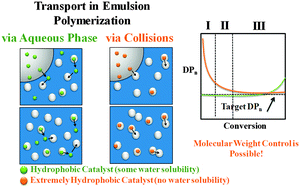An alternative mass transport mechanism, based on collisions between different entities, is used to explain the performance of an extremely hydrophobic catalytic chain transfer agent (i.e.COPhBF) in emulsion polymerization. Mass transport in emulsion polymerization is generally accepted to proceed via the aqueous phase. COPhBF possesses no detectable water-solubility and would therefore be expected to be inefficient for molecular weight control in emulsion polymerization. However, proper molecular weight control using COPhBF has been demonstrated and results are presented that are consistent with the existence of an alternative mass transport mechanism in emulsion polymerization that circumvents the aqueous phase.

